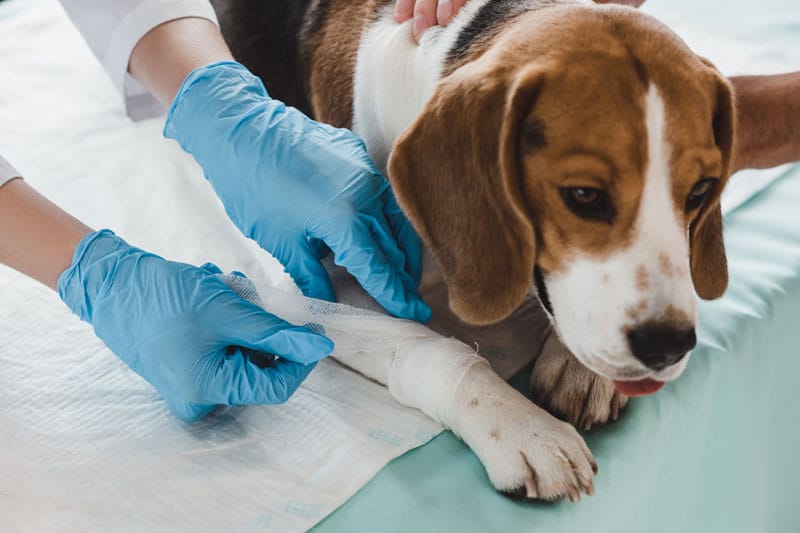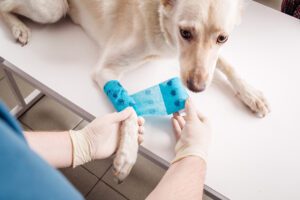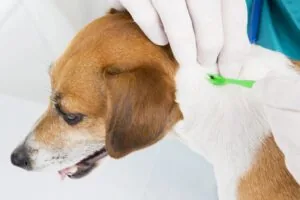Pet First Aid Awareness Month

April is Pet First Aid Awareness Month and because accidents can happen at any time with our pets, keeping an emergency first aid kit around and knowing how to perform CPR on your pet is always useful. Being prepared until you reach your veterinarian can help ensure the safety and health of your pet. Whether you’re dealing with a life-threatening emergency or just a few bumps and scrapes, it’s always a good idea to know the basics.
The following are the essential first-aid items you’ll want to have for your cat or dog:
- Pet First Aid Book
- Phone Numbers (Veterinarian, Poison Hotline, and closest Emergency Veterinary Hospital)
- Vaccine Records
- Photo of your pets
- Nylon Leash
- Muzzle (To prevent biting)
- Gauze Pads
- Adhesive Tape
- Antiseptic Wipes (Alcohol Wipes)
- Cotton Balls/Gauze Rolls
- Hydrogen Peroxide (To induce vomiting, only when directed by a veterinarian or a poison-control expert)
- Ice Pack
- Disposable Gloves
- Blanket or Towel (To use as a stretcher in case your pet needs to be transported and is not mobile)
- Petroleum Jelly (To act as a lubricant for thermometer)
- *Thermometer (Rectal temperature Canine Normal Range 100F to 102F, Feline Normal Range 99F to 102F)
- Scissors
- Non-Stick Gauze Pads
- Sterile Saline Solution
- Tweezers
- Triple Antibiotic Ointment
- Cornstarch or Styptic Powder (to stop bleeding)
- Nail Clippers
- Corn Syrup (For diabetic pets or small animals that have hypoglycemia problems)
- Diphenhydramine (In case of allergic reaction. Always consult a veterinarian for dosage)
It’s also wise to arm yourself on the basics so you can administer CPR before the veterinarian is able to treat your four-legged companion. Remember, CPR should only be administered if your pet stops breathing and you can’t feel his/her heart beat. Cardiopulmonary resuscitation is not child’s play. It can be dangerous if not administered correctly so never rehearse on a healthy dog or cat.
ABCs OF CPR
Airway, breathing, cardio/compressions. If your pet is choking, you’ll need to restrain them; hopefully you’ll have another person around to help. Open your pet’s jaws to see if you can detect the object. If it’s a stick or bone shard, use a large pair of tweezers to retrieve or break the object in half to relieve pressure. If a solid object like rawhide is jammed at the back of your pet’s throat, don’t push it with your fingers because you could lodge it even deeper. If no object is visible, don’t stick your fingers down your dog’s or cat’s throat because it could damage the delicate tissue that’s back there. For larger objects, like small balls or chunks of rawhide, place both thumbs under your pet’s jaw at the base of their throat and push firmly upwards. If you still can’t dislodge the object, rap sharply on your pet’s chest, similar to the Heimlich “punch” maneuver done on humans. If this doesn’t dislodge the object and open your pet’s airway, you should be well on your way to your veterinarian.
For dogs or cats who weigh 30 pounds or less, If you’ve established an open airway, but your pet is still not breathing and unconscious, you can start CPR. First, lay your dog or cat on their right side over a flat surface so their left side faces up. Extend your dog’s or cat’s head and neck. Use one hand to close their jaw, then form a seal by placing your mouth over your pet’s nose. Blow into his/her nostrils every three seconds. Make sure no air escapes between your mouth and their nose.
Check for a pulse: Bring your pet’s left elbow back toward their chest to locate their heart and pulse point. Locating a heartbeat on fatter, furrier animals can be tricky. Try to feel their pulse by running your finger along their inner paw down to their wrist area just below their dewclaw. If there’s no pulse, cup your palms above your pet’s heart. You can also put your thumb on one side of your pet’s chest, while keeping your fingers on the other side. Press down about an inch on the chest (a quarter or a third of the chest’s width) for a count of one, then release for a count of one 100 to 120 compressions per minute is recommended. Continue the compressions and respirations until your pet begins breathing again and their heartbeat is steady and/or your veterinarian takes over.
If your dog or cat weighs more than 30 lbs., you still lay them on a flat surface so their left (heart) side faces up. However, instead of compressing with cupped palms or fingers, you now flatten your palms, one atop the other, over your pet’s rib cage near their heart. Keeping your elbows straight, press down at a rate of 80 compressions per minute, rather than the 100 compressions you would do with smaller pets. Before you begin the respirations, place your hand over the larger dog’s mouth to close it as you blow air into his nostrils.
Doing anything for the first time is certainly stressful but if you memorize the ABCs of CPR, you’ll be less likely to panic in the case of an emergency.
Share This Post
Recent Posts
About Shallowford Animal Hospital
Shallowford Animal Hospital and The Pet Spa at Shallowford are dedicated to the exceptional, compassionate care your pet deserves. Pets hold a very special place in our families, and we treat yours like our own.



